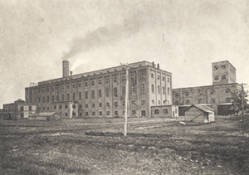Great Western Sugar Beet Factory (1904-1960s)
Introduction
Text-to-speech Audio
Images
Historic photograph of the Great Western Sugar Beet Factory. Photo from Fort Collins History Connection.

Backstory and Context
Text-to-speech Audio
The opening of the Great Western Sugar Company factory was a significant contributor to the population book of Fort Collins in the early 20th century. While not the beginning of immigration into Fort Collins, this sparked the largest movements of people to the town. Prior to the opening of the sugar beet factory, there was already a large population of Germans from Russia working in the fields.1
The two neighborhoods of Buckingham and Andersonville in current-day Northeast Fort Collins became the two sugar factory neighborhoods for the Volga Germans. They faced racial prejudice and slurs from some other Fort Collins residents, but they were hard workers and used that hard work to quickly move from contracted labor positions to tenant farmers and even to owning their own land.2 This left many open contract labor positions open soon after the Great Western Sugar Company opened the Fort Collins factory in 1904.
Hispanic families of many different origins moved to Fort Collins to fill the needs of the Great Western Sugar Company. Many of the people migrating to Fort Collins were American citizens who came from the New Mexico area where many families had lived long before the Mayflower landed in 1620.3 At this time in American history, laborers from Mexico were attracted to the area by wartime employment opportunities and the ease of immigration granted by the United States government during World War I. While some families did initially move to Fort Collins, the large majority of the people who traveled to Fort Collins were single male migrant workers who only intended to stay for growing season and leave in the fall.4
As a means of retaining skilled laborers, the Great Western Sugar Company built a community of adobe houses northeast of the factory for laborers to use year-round.5 The ability to afford a house close to work allowed a lot of autonomy for these workers and family members and an ethnic community, even if the Great Western Sugar Company ultimately owned the house and could control who lived in the community.6 The development of the “Spanish colony,” la Colonia, what is now known as Alta Vista, became a de facto Hispanic community, though some Hispanic families lived in Andersonville as well.
While this factory was demolished in the 1960s, it remains an important feature in Fort Collins history.7 The neighborhoods and religious spaces that were built to support the sugar beet industry's labor force still remain today as examples of living history. Visiting this site allows you to experience the isolation these communities felt from the rest of Fort Collins, something that greatly contributed to the prejudice many of these new residents felt. If you want to see a remaining piece of the factory, visit the sugar beet flume and bridge along the Cache la Poudre River.8
Sources
2. Germans from Russia in Fort Collins,” Fort Collins History Connection, accessed January 27, 2018,
https://history.fcgov.com/ethnic/german.
3. Gregory Chase, “Hispanic Migration to Northern Colorado During the Nineteen Twenties: Influences of Sugar
Beet Agriculture,” (dissertation, University of Denver, 2011), 51.
4. Adam Thomas, SWCA Environmental Consultants, “Hang Your Wagon To a Star: Hispanics in Fort Collins,
5. Adam Thomas, SWCA Environmental Consultants, “Hang Your Wagon To a Star: Hispanics in Fort Collins,
6.Adam Thomas, SWCA Environmental Consultants, “Hang Your Wagon To a Star: Hispanics in Fort Collins,
7. "Great Western Sugar Beet Flume and Bridge." Cache la Poudre River National Heritage Area. Accessed February 19, 2018. https://www.poudreheritage.org/locations/great-western-sugar-flume/.
8. "Great Western Sugar Beet Flume and Bridge." Cache la Poudre River National Heritage Area. Accessed February 19, 2018. https://www.poudreheritage.org/locations/great-western-sugar-flume/.
